

1 Georgian Architecture - Introduction
2 Georgian Architecture - Theory of Design
3 Georgian Architecture - Developments
4 Regency
5 Victorian Architecture - Introduction
6 Victorian - Style
7 Late Victorian and Edwardian Architecture - Change
8 Between the Wars, 1918-1939 - Part One
9 Between the Wars, 1918-1939 - Part Two
10 Between the Wars, 1918-1939 - Part Three
11 Post-War Housing, 1945-1960s - Introduction
12 Post-War Housing, 1945-1960s - Flats
13 Post-War Housing, 1960s Low Rise
|
Wherever you happen to be – London, Bath or Bristol, Edinburgh or Dublin – there is no mistaking Georgian housing (photo shows a late Georgian terrace c1790). Uniformity, symmetry and a careful attention to proportion both in the overall arrangement and in the detail characterised eighteenth century domestic architecture. We also describe the style today as ‘classical’. It was inspired by the architecture of ancient Greece and Rome that had been rediscovered during the Renaissance of the fifteenth and sixteenth centuries and re-codified by Andrea Palladio (1509-80) in Italy in the 1570s; and then re-interpreted again for the Georgian builder by eighteenth century British architects and writers such as William Chambers and Isaac Ware. Palladian taste promoted order and uniformity...as Ware stated, ‘There ought to be...a uniformity of all the parts first to the whole building and next to each other’. |
 |
| Guided by the published rules and conventions of ‘Palladian’ architecture, Georgian house builders swept away centuries of ‘vernacular’ house building rooted in local traditions and materials: timber framed construction, gabled roofs and casement windows and other features of the vernacular disappeared in the first few decades of the eighteenth century. |
| The new style can be traced back to mid-seventeenth century London, to Inigo Jones (1573-1652) and his design for Covent Garden, a Palladian inspired formal square of the 1630s. Then following the Great Fire of 1666, large-scale speculative building of classically influenced brick town houses commenced in London and by the end of the seventeenth century similar developments were under way elsewhere. In Bristol, then one of the largest and most important provincial cities, one of the first brick houses in the city was completed in 1701 in a new formal square soon to be named after Queen Anne (1701-14). The building of these first Georgian streets and squares represented the beginnings of large-scale suburban development in Britain. ‘Noxious trades’ were usually excluded from these new developments by the terms of the original building leases. Developed by speculative builders for wealthy clients the Georgian suburb was intended to be purely residential. These were the first fashionable suburbs containing streets, squares, circles and crescents of elegant terraced houses which exemplified the best of Georgian good taste: a combination of judicious restraint with exquisite detailing of the doors and windows. |
 |
|
38 Queen Square, Bristol, c. 1703 with moulded string courses at each level and wooden modillioned eaves cornice. |
29 Queen Square, Bristol, 1709-11 with alternate segmental and triangular stone pediments over the ground and first floor windows. |
| The terraced house arose from the need of the speculative builder to squeeze as
many houses as possible into one street. So the typical Georgian town house was
tall and narrow with a long narrow garden or court behind and for the largest
houses a coach house or stable at the rear of the plot served by a subsidiary
road or ‘mews’. The back yard usually contained a privy or ‘bog house’ - a
primitive sanitary arrangement set over a cess-pit or ‘bog hole’. All houses
except the poorest had basements containing a kitchen, a back kitchen or
scullery and various stores - pantry, larder and storage for coal. The coal
store often extended under the pavement so that the coal could be delivered
without entering the basement: the circular cast-iron coal hole covers
remain a feature of the pavements in many Georgian streets.
At the front the basement often looked onto a deep void below the street called the ‘area’ which often contained ‘area steps’ which provided a tradesmen’s’ entrance directly into the kitchen. The plan of the house was usually extremely simple with one room at the back and one at the front on each floor with a passage and staircase at one side although inevitably there were many minor variations on this plan. The party walls of the houses usually contained the chimney flues which added strength to the structure. Large houses would contain up to twenty-five or more individual flues which were swept of soot by young climbing boys. |
|
|
Outside areas where good building stone was available, brick was the universal Georgian building material. In London the bricks of good, hard quality used for the outer walls were known as stocks whilst poorly made ‘place’ bricks which included as much ash as clay were used for cheapness sake for the unseen work of party walls and partitions. The stocks used in and around London were of two colours: grey and red, the latter being a trifle more costly and often used for lintels and window arches whilst the grey bricks were preferred for walling in general. In the latter part of the century London stocks were almost uniformly a pale, yellowish brown. A fourth more expensive type of brick was the cutting brick, a crimson brick of very fine sandy quality and capable of accurate cutting – hence the name - but they were also known as ‘rubbing brick’ or ‘Windsor brick’. In the best work these were used instead of red stocks for window arches and decorative dressings (photo shows rubbed brick window arch c1740). The Georgian bricklayer almost invariably laid his bricks in ‘Flemish’ bond in which the headers and stretchers alternated in each course. After bricks timber was the Georgian builder’s chief material: Baltic fir and oak were widely used and from about 1720 mahogany was used for the more expensive items of joinery, such as interior doors and the beautifully crafted handrails of Georgian stairways. For the paving of the halls of large houses, Purbeck stone was often specified often with little diamonds of black Namur marble at the crossing of the joints. The principal rooms were distinguished by white marble fireplaces which contained freestanding ‘stove grates’ of burnished steel and brass and ornate ceiling plasterwork. Rubbed brick window arch, Bridgnorth, Shropshire, c. 1740 |
|
|
Georgian theories of proportion and symmetry governing the design of the façade were developed in the early eighteenth century and derived from the classical temples of Ancient Greece and Rome. Adapting Palladio’s principles, the Neo-Palladians created a system of proportions and ratios based on the square and circle (or cube and sphere). The square, in particular was considered the key to architectural beauty: and Robert Morris (1703-54) in his ‘Lectures on Architecture’ of 1734 and 1736 established seven ideal proportions, all based on the cube. Proportions based on squares were used to determine window openings and the system of window openings relative to wall areas, thus if the house was three bays wide (the usual width of the Georgian town house) then the space occupied by the first and second floor windows would usually be made roughly a square. Picture shows Dowry Square, Bristol, c1750. |
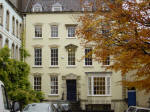 |
| For the Pallladian façade this system of proportions was combined with the architectural elements of the Roman temple consisting of a rusticated basement, columns or pilasters, entablature (including the cornice and pediment) and attic. Five types of columns with the superstructure they supported – known as the Five Orders – were used to determine the adornment of the façade (see drawing below). The Five Orders were the Tuscan, Doric, Ionic, Corinthian and Composite and were easily distinguished by the particular carving of the capitals and their individual proportions. The Orders were applied to a building for decorative purposes and also to ‘order’ the design of the facade. The Orders were either applied to the facade or implied by dividing the facade in height according to the divisions of an individual column. Even where the main architectural components of the temple were absent their presence could be implied by the use of certain details. Thus a cornice or even a flat string course was used to suggest the location of the entablature, or a sill band or string course at first floor level could be used to indicate the line of the column base while another above the ground floor windows could be used to indicate the junction between the column pedestal and temple podium. In a three storey high house, for example, the temple composition was implied by the ground floor storey corresponding to the area of the podium while the two stories above fell within the area of the column shaft. For the largest and grandest terraced block the temple formula provided further inspiration for the front. By adding a pediment over the centre the row was given a palace-like front. Now the overall unity of the design was more important than the facades of individual houses. John Wood (1704-5) adopted the palace front for the north side of Queen Square in Bath, started in 1728, and thereafter the pediment was widely used. |
|
|
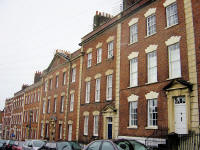 |
|
The Five Orders of Ancient Architecture, from left: Tuscan, Doric, Ionic, Composite and Corinthian. From Nicholson’s ‘New Practical Builder’, c1824 |
Albermarle Row, Hotwells, 1763. A uniform row of seven houses with the central one raised slightly forward to form the central feature with a pediment. |
Georgian town houses, St Mary’s Street, Bridgnorth, c1740 |
| If Palladianism encouraged uniformity and consistency there was still, nevertheless, considerable scope for the details of the façade - particularly of the proportions and placing of windows and the designs of door cases - to evolve during the eighteenth century. Taste and fashion and building controls were the two chief determining factors. In order to reduce the risk of fire in 1707 a Building Act was passed which banned the prominent eaves cornices, which had risen to popularity in Restoration London. Instead, the roof was half hidden by a parapet wall with a cornice of brick, stone. Two years later another act laid down that the window frames, instead of being nearly in the same plane as the brick face were to be set back four inches leaving a reveal of brickwork which gave a sense of solidity to the walls. The early eighteenth century also saw the widespread adoption of sash windows replacing casement windows. The sash, a Dutch invention had been known for many years but its popularity only dates from Queen Anne’s time. Unlike casements, sash windows could be opened without disrupting the classical facade. The two sliding frames usually contained six panes of hand blown ‘crown’ glass and these usually varied in proportion according to the dimensions of the window. | ||
| In the late seventeenth century, the ground floor was often treated as the principle storey but in houses of early eighteenth century date the ground and first floor windows are often found to be roughly the same size while second floor attic rooms were lit by square windows. The piers between the windows of early eighteenth century houses were often considerably narrower than the openings although the early Palladians favoured the reverse ratio with the piers being considerably wider than the windows. Later the width of window openings and piers was almost invariably fixed at between three feet five or six inches. By the mid-eighteenth century, the first floor was established as the main floor – the ‘piano nobile’ - and had the highest ceilings and tallest windows. By the mid-eighteenth century first floor windows were usually a double square and sometimes given further pre-eminence by the use of architraves and full entablatures as in Bath and Bristol. Then in the late eighteenth century the principle floor returned to ground level. | ||
| The main entrance formed the dominant ornamental feature of the facade although doors were only placed symmetrically on detached houses. In the terraced house, the door was almost invariably placed at one side of the facade so that a two bay room – the parlour – could be located to the side of the entrance and hallway. Early eighteenth century porticos were generally made with heavy brackets supporting a hood, sometimes in the form of a shell. In the 1720s and 1730s, Palladian designs based on the temple were widely used for door cases with pillars supporting an entablature and pediment variously of ‘segmental’ (curved) or ‘broken’ form. In London, porticos were commonly made of white Portland stone which contrasted with the brick walls. Doors were usually of six panels. Early doors were tall and filled the entire opening but in the 1720s the fan light – a semi-circular window over the door - first appeared as a means of allowing light to enter the hall. The entrance of many Georgian town houses was further embellished by delicate wrought-iron work including area railings and supports for oil lamps which arched over the entrance. | ||
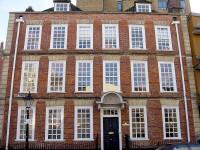 |
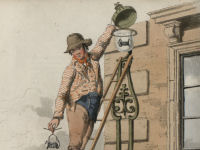 |
6 King Street, Bristol, c1720 with scalloped shell hood supported by carved and scrolled consoles. |
Oil lamp holder, from Pyne’s Costume of England, 1809 |
|
From the 1760s the strict conventions of Palladianism were challenged and then modified by a new breed of professional architects of whom the greatest were Robert Adam (1728-92), his younger brother James (1732-94), Sir William Chambers (1723-96) and James Wyatt (1746-1813). Robert Adam was the leading force in creating a new style, spending several years abroad and examining sites of antiquity at first hand. He denounced the eternal repetition of the same traditional classical elements and brought a greater degree of flexibility to the interpretation of classical architecture. Inspired by his study of the ruins of Diocletian’s Palace in Dalmatia, he also introduced a new range of decorative motifs. The result was a new architectural style which is generally known as Neo-classical or even simply as ‘Adams style’. It was characterised by buildings with light, elegant lines unbound by strict classical proportion. Adam treated ornament freely – introducing delicate swags and ribbons into his interiors which were painted in delicate greens and blues, lilacs, dove greys and faint yellows. The fan light was a prominent feature of Adams style. They were at the peak of their popularity between 1760 and 1780 when they consisted of a complex pattern in iron and lead typically of spokes radiating outwards from a central floret and decorated with swags and garlands. Windows were taller with thinner glazing bars. Lower down the social scale, smaller houses were built to precisely the same proportions only on a reduced scale. The distinctions were codified in the great Building Act of 1774 which aimed at preventing poor quality construction and reducing the risk of fire. By the Act, houses were categorised or ‘rated’ according to value and floor area. Each rate had its own code of structural requirements as regards foundations, external and party walls. |
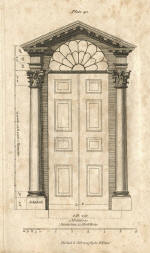 |
|
|
|
|
|
First rate house (from Nicholson 1823) |
Second rate house |
Third rate house |
Fourth rate house |
From the middle of the century, bay windows which had been out of fashion since the early seventeenth century began to reappear. Many were confined to the ground floor parlour beside the front door and were frequently of timber construction. The roofs of early Georgian houses were tiled but towards the end of the eighteenth century Welsh slate was widely adopted. After 1750, water closets were installed in the best houses: Robert and James Adam installed them in Osterly House and Syon House, London, in the early 1760s. From about the same time the freestanding stove grate was replaced by cast-iron hob grates which filled the chimney opening. These were usually cast with the delicate neo-classical motifs popularised by the Adams Bothers who were directly responsible for the designs found on the grates made by the famous Carron Foundry in Scotland in the late eighteenth century.
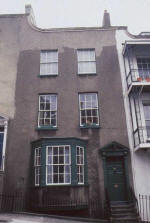 |
|
Granby Hill, Hotwells, Bristol, 1789 |
Adams style cast-iron hob grate, 1798 |
|
The end of the Napoleonic Wars in 1815 saw the beginning of a twenty year long building boom and of a new style of architecture which took its name from the Regency of the Prince of Wales, later George IV, which lasted from 1811-1820. In London large impressive terraces were built by John Nash (1752-1835) the Prince Regent’s leading architect - and subsequently Thomas Cubbitt. Elsewhere, in Brighton, Cheltenham and Leamington Spa, for example, the building of Regency housing was on a scale large enough to give these towns and other genteel spa and seaside places an enduring ‘Regency’ character. As in London, large, handsome terraces remained a popular form of housing for the well-to-do. In basic plan these continued to follow the traditional eighteenth century layout with a basement service area but the Regency period was also notable for the rise of the detached and semi-detached villa. In the context of British domestic architecture the term dated from the 1820s when Nash included picturesque villas in his development of Regent’s Park although separate dwellings had been seen in St John’s Wood as early the 1790s. Builders continued to follow well proven Georgian principles of design and construction - as exemplified by writers such as Nicholson in 1823-5 - but from the early 1800s, house building took several new directions which were to give Regency architecture its own particular identity. |
|
| Regency architecture was, above all, typified by the use of stucco in preference to exposed brickwork (above right). Stucco is a general term used for various kinds of cement coating applied to the external wall of a building. Its use dated from around the time of the Building Act of 1774 when various patent stuccos were introduced; they were used sparingly until Nash popularised their use in his fashionable developments in London. Several new formulas for artificial cements’ were developed in the early nineteenth century when the use of stucco rapidly increased as means of imitating stone; all respectable stucco buildings of the eighteenth and early nineteenth century were carefully scored with horizontal and vertical lines to represent stone jointing. The simplicity of a uniform stuccoed facade painted white, cream or buff provided the perfect foil to the use of plain, slightly projecting bands and restrained ornament. For large terraces – like Carlton House Terrace begun by John Nash in 1827 - the Orders were still applied. Their facades continued to be arranged in the grand Roman manner with giant columns and pilasters although the use of smaller accents of ornament came to typify Regency architecture. |
|
| Georgian proportions continued to determine window proportions, thin glazing bars still divided sash windows into twelve or more rectangular panes. Doorways continued to be surmounted by fan lights: semi-circular designs were still found but many were now rectangular with delicate vertical muntins which were either arched or angled in imitation of Gothic window tracery. In terraces, the top of the facade was finished in typical Georgian style with an elegant parapet hiding a low roof. These were either pitched at right angles to the front with a central valley or were of mansard construction in which case they were aligned to the ridge and tall enough to contain attic rooms with dormer windows looking out over the parapet. Villas were often given low pitched roofs of gabled or hipped construction with wide projecting eaves. Welsh slate was now the preferred roofing material and formed a striking contrast with the walls when these were of pale coloured stucco. |
|
| Some terraces – notably some of those close to the sea front at Brighton – were built with large sweeping bays so that every house had at least a glimpse of the sea and elsewhere the slightly curved ‘bow’ windows became another feature of Regency architecture. Delicate balconies of wrought or cast-iron with curving metal roofs resembling Chinese pagodas became popular at first floor level. French windows, which were really glazed doors, opened on to the balconies or in the case of villas were placed in rear ground floor rooms to provide direct access to the garden. |
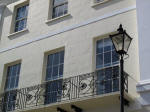 |
| Regency housing represented a new type of classical architecture which drew on a wider range of sources than ever previously seen. It represented a challenge to the straight jacket of Georgian Palladianism and the first break with classical restraint can be traced to the emergence of the ‘Picturesque’ movement in the 1790s. Through the Picturesque, traditional vernacular English forms, continental styles from Italy, France and Switzerland and more exotic elements such as Indian verandas and domed towers were incorporated in Regency domestic architecture – from Nash’s fantastical Brighton Pavilion of 1815-23 to the cosy cottages of Blaise Hamlet near Bristol which Nash also conceived in about 1810. Then from the early 1800s, through the work of architects such as Robert Smirke (1781-1867), a fashion for Grecian inspired ornament emerged. Greek Revival architecture found its best expression in large public buildings but it also found its way into suburban ‘villa’ development where large detached and semi-detached houses were built with fluted pilasters and ionic capitals supporting pediments and window surrounds and porches dressed with delicately carved Greek inspired motifs. Another strong influence which appeared from the 1820s was the ‘Gothic’ which had first appeared in the mid-eighteenth century. It was a style best suited to the small villa or cottage where a delightfully picturesque effect was achieved by placing doorways and windows in ogee or early Tudor, four pointed arched openings. The windows were filled with delicate Gothic arched glazing bars and leaded lights. These styles were brought together and popularised by writers such as Francis Goodwin and John Claudius Loudon (1783-1843). Loudon’s highly influential ‘Encyclopaedia of Cottage, Farm and Villa Architecture and Furniture’, first published in 1833, contained over 2,000 designs for houses in a variety of ‘romantic’ styles: Grecian, Gothic, Old English, Swiss chalet style and others. For the supporters of Georgian architecture the appearance of these guides marked a turning point in British architecture – the start of a ‘descent into chaos’ - as the conventions of Georgian architecture were swept away. | |
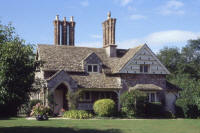 |
|
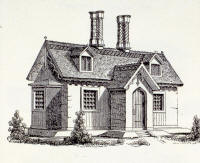 |
Double Cottage, Blaise Hamlet, Henbury, Bristol, by John Nash and George Repton, c1810 |
Regency Grecian, Buckingham Vale, Clifton, Bristol, c1840 |
Cottages in the Gothic style from J.C. Loudon,’ Cottage, Farm & Villa Architecture’, 1833 |
|
Regency architecture survived Victoria’s accession in 1837 and houses with ‘Regency’ characteristics continued to be built through the 1840s but gradually and imperceptibly, Victorian architecture emerged as a style of its own, shaped by rapid population growth, the influence of new technologies and new materials and also, the intellectual input of theorists such as Augustus Welby Northmore Pugin (1812-52), John Ruskin (1819-1900) and William Morris (1834-96). But first population: during Victoria’s reign, Britain’s population doubled with the urban based proportion increasing from 54% in 1851 to 79% by 1911. The result was a massive expansion of towns to which the speculative builder responded building suburbs which were sharply delineated by class. Working class districts were built cheek-by-jowl with the collieries, mills and factories which provided employment for their inhabitants. The housing generally consisted of rows of tightly packed terraces: although no longer fashionable after the 1850s, the terraced house remained the builder’s solution to the demand for cheap urban housing until the early 1900s. Cheap on land and materials they were either built back-to-back so that the rooms had no rear windows – or as through houses - which usually had a two storey rear extension containing the kitchen and a small third bedroom and with a privy (or W.C) and coal shed in the back yard. Whilst the back-to-backs and the poorest through houses were completely devoid of any embellishment or ornament, bay windows, moulded brickwork and other details were added to larger terraces which commanded higher rents and pretensions to respectability. But there was no mistaking the true Victorian middle class dwelling. Whether detached or semi detached, these solidly built and substantial houses were large enough to accommodate resident servants, the employment of at least one being a clear indicator of middle class status. |
|
|
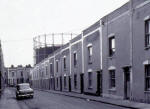 |
|
 |
Back-to-back houses from Woodsettton, south Staffordshire, c. 1850s, rebuilt at the Black Country Living Museum, Dudley. |
Through terraced houses with parapet facade, Barton Hill, Bristol, c1875 |
Through terraced houses, Albion Terrace, Chester |
Hallway of through terraced house, Bedminster, Bristol, c1890 |
|
Whilst a typical working class house contained between four and six rooms, a large middle class villa of the 1850s or 1860s could contain twelve rooms or more with separate family and service areas. The family rooms included bedrooms with adjacent dressing rooms, a W.C. but rarely a bathroom, large reception rooms with high ceilings, elaborate moulded plaster cornices and marble fireplaces. The servants were usually accommodated in attic rooms whilst the service area continued to occupy a basement containing kitchen, scullery, pantry and larder - a separate servants’ W.C. - and in the largest, a housekeeper’s room or servants’ hall. The houses were private and respectable. They were usually given names which reinforced their grandeur and respectability – ‘Albion’, ‘Richmond’ and ‘Belmont Villa’, for example, and they were usually set back from the road in gardens which, for the first time since the middle ages, became an important part of the urban home environment. |
|
|
The range of styles available to the Victorian architect helped underline the separateness and individuality of the larger Victorian house. From the 1830s, Gothic emerged as the greatest challenge to the dominance of Classical styles. Through the influence of Pugin whose ‘True Principles of Gothic Architecture’ was published in 1841, a more serious and analytical approach to the use of medieval Gothic architecture emerged. Then in 1851-3, the art critic, John Ruskin, published ‘The Stones of Venice’. This became a key text for the High Victorian Gothic of the middle decades of the century and through Ruskin’s influence elements of the Italian Gothic including pointed arched window surrounds, elaborate polychrome brickwork and carved stone decoration, was brought into the leafy suburbs of Victorian Britain. Italian architecture of the sixteenth century was another style which was widely used for large suburban houses in the middle of the century. It had its roots in Regency architecture when Nash had experimented with a semi rustic Italianate villa style and was further developed and popularised in the 1830s by Sir Charles Barry who drew heavily on the buildings of the Italian Renaissance. Osborne House, on the Isle of Wight, designed by Cubitt, for Queen Victoria and Prince Albert and completed in 1851 was the grandest example and provided the inspiration for many large villas built in the 1850s and 1860s. Typical features included a square, ‘belvedere’ tower, deep projecting eaves, roof balustrades and round arched windows. Other styles found included the Northern European – typified by the use of the curved or Dutch gable – the French Baroque – which contributed the mansard roof - and Elizabethan and Jacobean which contributed features borrowed from the typical ‘Jacobethan’ large house, including towering chimneys, mullioned windows and four pointed arched front door ways. |
|
|
|
|
Italianate villa, c1860 |
Italianate villa, c1870 |
Belvedere tower on a villa of c1860, Clifton. Bristol |
| These various styles posed a major challenge to the Neo-Palladian rules of geometry and proportion: in place of broad sweeps of wall surface with windows cut in simply and sharply, there was a new emphasis on anything picturesque – on the, ‘charming character of the irregular’. Architectural historians write of the ‘Battle of the Styles’ but it was usual for an architect to select a particular architectural style according to the whim of the client. Styles were also amalgamated and motifs mixed so freely in a profusion of detail that it can be difficult to identify between the various revivals. But whatever the choice or mix of styles, the popularity of certain features provided some common characteristics. Large bay windows – often of two or three stories with heavily ornate surrounds – became a dominant feature of the facade after 1850.The bay window contributed to the picturesque quality of the front but from the inside it offered more space and light – and better views. The halving of the window tax in 1832 and its repeal altogether in 1851 encouraged the use of large windows. They were usually filled with large areas of glass thanks to the perfection of ‘Improved Cylinder Glass’ by Robert Lucas Chance in 1832. |
|
| Sash windows remained standard in the mid-Victorian house but the availability of large sheets of cheap glass resulted in larger individual panes and fewer glazing bars. An entire sash could be filled with one sheet of glass and being heavier the frame of the sash had to be made thicker and strengthened with full mortise and tenon joints at the corners giving rise to the ‘horns’, the vertical extensions to the styles, which appeared on sashes after about 1840. On larger early and mid-Victorian houses, the windows were often fitted with internal wooden shutters whilst roller blinds which kept direct sun light out of rooms were frequently added to the exterior; many of the ornate wooden blind boxes survive and can be seen framing the upper part of the window opening. The prominence of the front bay had a curious effect on the position of the front door of larger mid-Victorian houses: it was sometimes found relegated to a less prominent position - even a side wall. By the 1850s the commonest type of front door had four panels in place of the typical Georgian six panel door. Door furniture tended to be heavily ornate and made of cast-iron and following the introduction of the penny post in 1840 usually included a letter box. |
|
|
Roofs became another integral part of the facade. They were generally pitched steeper and through using hips and gables embellished with elaborate wooden barge boards and ornate ridge tiles and finials. Multi storey bays were usually given their own steep roofs joined to the front pitch of the main roof. Slate remained the commonest roofing material across much of the country. Chimneys were also now regarded as a positive feature of the overall design: they were generally tall and decorated with projecting courses of brickwork, stone carving and other ornament reflecting the overall style of the house. This extended to the chimney pots which were made in a wide range of decorative designs, each with their own particular names such as ‘crowns’ and ‘bishops’; some incorporated elaborate projections to counter down draughts. All these features, of course, added to the picturesque quality of the architecture which was further enhanced by a return after the mid-century to the use of undisguised red brick and in stone areas, rubble walls. From the 1860s, the use of ornamental brick and terracotta – clay baked at very high temperatures to produce a material claimed to be stronger than brick or stone – became popular for detailed embellishments although later generations were to condemn the Victorian love of manufactured detail ornament. |
 |
| Gradually, a reaction set in to the mixed classical and Gothic styles of mid-Victorian architecture and to the artificiality – and perceived ugliness - of machine made building parts and fittings. The result was the emergence of the Arts and Crafts Movement which created a new aesthetic approach in all fields of design based on a search for greater ‘truthfulness’ and simplicity in design. In domestic architecture it led to the rise of a new style frequently referred to as the ‘Old English Revival’. This can be traced to the building of the Red House at Bexley Heath, Kent, designed by Philip Webb (1831-1915) for William Morris in 1859. Rejecting machine made decoration, Morris and his circle of friends made some of the fittings - including the stained glass and tiles - themselves. The house was built of red brick with a high pitched, red tiled roof and incorporated such romantic features as a turret, oriel windows and gables. It marked a return to the vernacular tradition of building and became, in the words of John Cloag, ‘the progenitor of a new school of domestic architecture’. Much imitated, it became a dominant influence on the so-called ‘stock broker belt’ housing – large detached houses built mainly in southern commuter villages like Gerrards Cross, Buckinghamshire up to 1939. | |
|
In the 1890s, a new interpretation of the Old English Revival emerged through the work of C.F.A. Voysey (1857-1941) and Sir Edwin Lutyens (1869-1944). In some of his country houses, Lutyens combined classical style with the use of local materials as at Heathcote, Yorkshire. The houses of Voysey and his followers built in the early 1900s for wealthy clients struck a modern look with their low ceilinged rooms, horizontal windows, roofs sweeping almost down to ground level and white rough cast or pebble dash walls, although Voysey always saw himself as an architect working firmly within the traditions of English vernacular architecture; his use of pebble dash, for example, came from the traditional harling of Scotland and Cumbria. The photo on the right shows The White House by Dare Bryan after C. F. A. Voysey, Leigh Woods, N. Somerset, 1901. |
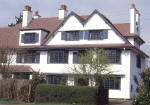 |
| Another widely found late Victorian style is generally known as the Queen Anne Revival. It was developed by the architects, W. Eden Nesfield (1835-1888) and J. J. Stevenson (1831-1908), in the late 1860s although it is more usually associated with the building of Bedford Park, Chiswick by R. Norman Shaw (1831-1912) between 1875 and 1881. The style also borrowed details, such as tile hanging, from vernacular architectural traditions but it also marked a return to more symmetrical classical compositions using English and Dutch Renaissance details and the use of red brick relieved by white painted woodwork. With its winding tree lined roads, Bedford Park has been hailed as the first garden suburb. The houses were individually built and incorporated a number of important technological developments which emerged after 1870. Chief amongst these was the introduction of improved sanitary arrangements including properly trapped and ventilated house drains and the inclusion of a bathroom in the first floor plan. Another departure from long established conventions was the abandonment of the basement service wing in favour of a kitchen located on the ground floor. |
|
|
|
|
Queen Anne style semi detached villas, c1890 |
Queen Anne style houses, c1895, Henleaze |
Downs Park East, Henleaze, c1910 |
| From the 1880s through to the early 1900s, Shaw’s work was much imitated by speculative builders for middle class housing and large, fussy, red brick houses with porches, wooden verandas, small window panes in the upper sashes - and the occasional Dutch gable - became a familiar part of the outer suburbs of London and other large towns and cities. Stained glass became popular for front doors and porches while the floor and dados of porches and hallways were often finished in decorative tiles which were produced in huge quantities from the 1870s. After 1905, pargetting – decorative relief plasterwork - recalling the seventeenth century domestic architecture of Essex and Suffolk – pebble dash and half timbered gables became popular. In the hands of speculative builders, suburban villas began to look like enlarged cottages. Although roofs were prominent, houses were generally not as tall and there was now a greater horizontal look to the facade. Plans tended to be squarer and without a basement the main living rooms now had direct access to the garden. |
|
|
Some of these features found their way down to the better quality artisan terraced house built around 1900. Often with their own name in imitation of the larger house, these were villas within a terrace; they provided homes for the upwardly mobile artisan and clerk – like the fictitious Mr Pooter of ‘The Laurels’, Holloway, London. Terraced houses of between four and six rooms remained the answer for mass urban housing. Typically laid out in straight, monotonous streets with little open space and erected by small builders employing local methods and material they still exhibited considerable local and regional variety. From the 1870s, national and local legislation aimed at improving public health at least ensured that basic standards of construction, sanitation and adequate space – front and back - were maintained. |
|
| The First World War marked a watershed in British house construction. For the first time, the large-scale provision of working class housing became the responsibility of the state while the building of middle class homes for owner occupiers was subject to new pressures, such as the arrival of electricity, the rise of the motor car and the expansion of a servantless lower middle class. The building of both the new council estates and the development of middle class suburbs by private developers in the interwar period was heavily influenced by the Tudor Walters Report published by the Local Government Board in 1918. This drew heavily on the garden city movement which had emerged in the the late nineteenth century through the building of model industrial villages like Port Sunlight and the publication in 1898 of the seminal ‘Tomorrow: A Peaceful Path to Real Reform’ by Ebenezer Howard (1850-1928). Together with expert opinion provided by specialist groups including women’s organisations, the report set the die for the creation of entirely new house types. |
 |
| House building had come to a virtual standstill during the war creating an acute shortage of housing nationwide. The government acted with a Housing Act in 1919 which required local authorities to assess their housing needs and make good the deficiency with the assistance of a generous government subsidy. The Addison Act was replaced by housing acts of 1923 and 1924 and further acts which promoted the construction of council houses were passed in the 1930s. The design of the council estates followed the principles laid out by Raymond Unwin (1863-1940), the chief author of the Tudor Walters Report and a leading exponent of the garden city movement; he had been one of the chief architects of Letchworth, Hertfordshire, the world’s first garden city, founded in 1903. The estates were to incorporate a mix of house types in a relaxed setting with no more than twelve an acre. The idea was to create a garden village – or garden suburb - and so many 1920s council houses were built in a simple cottage style with gabled, red tiled roofs, brick walls combined with white render or pebble dash and horizontal casement windows. Houses were built in pairs or in short terraces runs of up to about five houses. They were generally low and wide, roofs were hipped and chimneys low and squat. Gardens, front and back, were usually of generous dimensions. |
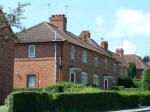 |
| The Neo-Georgian style which had appeared before 1914 was also widely used for the council estates; it was typified by the use of red brick and simple Georgian style door cases. The plan of the typical interwar council house was generally rectangular: the rear extension, typical of Victorian terraced houses was abandoned to ensure the back received as much light as the front. Houses divided into parlour and non-parlour types but they were all provided with a scullery, bath and indoor W.C. |
 |
| There were also experiments with non-traditional building methods – such as the use of metal frames, cast-iron or concrete - as a means of reducing costs although these constructional techniques brought their own problems such as poor insulation and condensation. The photo on the right shows a pair of cast-iron council houses, Dudley, 1925, reconstructed at the Black Country Living Museum, Dudley. |
|
| The council estates built as a consequence of slum clearance projects in the 1930s saw standards of accommodation drop with the building of more non-parlour houses. If the creation of the council estates was in part, a Utopian vision to create a healthy, pleasant home environment for ordinary people, the economies imposed on the quality of the houses resulted heavy criticism of the monotony of the architecture and the setting. By the mid-1930s some large authorities, including the London County Council, Liverpool, Manchester and Leeds turned instead to the building of council flats. By the late 1920s, the flat movement was beginning to gain strong support from architects of the ‘Modern Movement’ who were inspired by the large workmen’s flats built in Vienna in the 1920s. Gradually the idea of living in multi-storey accommodation began to gain acceptance and in London, flat building exceeded cottage building for the first time in 1936. |
 |
| By 1939, 1.1 million council houses had been built but this figure was outstripped by the 2.8 million middle class homes built by speculative builders from 1923 when private house building resumed after the war. The rate of building increased in the early thirties reaching a peak in 1936 when 370,000 houses were completed. The commonest house type was the three bedroom semi-detached house although developments often included detached houses and bungalows. |
 |
|
The bungalow came into its own between the wars. Whilst some were built in pairs, the detached bungalow was common and this provided an affordable way of achieving the goal of living in a detached home. They were also claimed to be less expensive to furnish and cheaper to run than a conventional house. There were also bungalows with a bedroom or two in the roof lit by a dormer window in the roof. Like the council house, the typical privately built semi adopted a rectangular plan with a small kitchen – often called a ‘kitchenette’ – within the main block. A serving hatch was another innovation of the time, linking the kitchen with the dining room whilst the latter usually had French windows opening to the back garden. Occasionally the kitchen was located in a rear extension but this was always of one floor. Generally the houses were low and wide and of just one storey – the first floor containing three bedrooms and bathroom with the W.C. often located in a separate room. Introduced from the United States in the late twenties, coloured bathroom suites became popular in the 1930s finished in a range of colours including pink, green, and primrose yellow and for the avant-garde, black. |
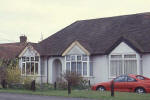 |
| The overriding style of the typical thirties ‘semi’ was retrospective borrowing heavily from traditional vernacular motifs. Today it is frequently described as ‘Tudorbethan’ or ‘Tudoresque’ but at the time it was much derided by architectural critics. In 1938, Osbert Lancaster(1908-86) wrote of the ‘By-pass Variegated’ house and condemned the ‘infernal amalgam’ of past styles so commonly seen. The dominant feature was the front bay – usually of two stories – which was surmounted by a large prominent gable typically dressed with barge boards and fake timber framing in imitation of sixteenth and seventeenth century vernacular housing. |
|
| The bays were variously square edged or set at an angle (canted). Curved bays were also popular –either tucked under deep projecting eaves or surmounted by a projecting gable supported from below by open timber brackets. An oriel window was commonly used for the small third bedroom over the front door whilst halls and landings were well lit by small widows on the ground floor – variously shaped square, round or diamond – and long vertical windows over the stairs. Breaking with some two hundred years of formal architectural practice, the sash window was abandoned in favour of casement windows with top hung upper lights in stout timber frames. |
 |
| The casements were typically painted cream contrasting with frames painted a darker colour such as mid-green or chocolate brown. There was another window in the front door: these were variously round, square, square with a wavy arched top or commonly of a horizontal oval (with a drip rail above) and arranged over long vertical panels. There were usually long vertical glazed panels either side of the door and the whole ensemble was commonly placed in a large, round arched, open porch and this, along with the timbered gable and bay window, forms one of the most recognisable stylistic components of a privately built thirties house. Many of the windows were decorated with leaded lights and stained glass which was usually combined with wavy or rippled glass. Much 1930s stained glass was in the modern style, relying on bold splashes of colour in geometric lead work: a popular design consisting of long rays of contrasting coloured glass spreading outwards from a small ‘rising sun’ of red or yellow glass although a Tudor galleon tossed on stormy seas was another widely found motif which, of course, struck a more traditional note. From the general run of the ‘Tudorbethan’ house, a few were given a pseudo-Gothic finish by substituting an embattled parapet for the usual gable. So, there was extraordinary variety to privately built inter-war housing – not only from one development to the next - but very often in the same road as builders deliberately widened the choice of houses available for sale. And yet, apart from the few houses finished in local stone, it is impossible to attribute any regional pattern to any of these styles. |
|
| The timber framing of the typical thirties semi had no structural function. Most houses were built of brick and notwithstanding a few well publicised exceptions the quality of construction was excellent. This was the period when cavity wall construction became standard and walls in stretcher bond laid with Portland cement in place of traditional lime mortar. But these were no glory days for the humble brick. The days of the locally handmade brick which gave such character and charm to Georgian and Victorian houses were replaced by mass produced bricks such as the harsh, pinkish Fletton. Large expanses of brick were frowned upon so first floors were often rendered or covered in pebble dash - that is, pea shingle which was thrown against the final render coat. Alternatively, the shingle was mixed in with the render to create rough cast. Some houses were covered entirely in pebble dash which arguably looked as harsh as the red brick underneath. However, brick could be used decoratively to help create the retrospective character of the thirties house with brick nogging– that is, brick infill in a timber frame. |
|
| Alternatively, the bays were clad in tile hanging, another vernacular tradition. The roofs were usually of hipped construction although in the late 1930s, inspired by Hollywood, green tiles enjoyed some popularity. Recalling the work of Voysey, some roof gables swept down to ground level with a mass of Tudor style black and white timber framing to contain the porch. |
|
| Whilst the typical interwar middle class house was smaller than its Edwardian and Victorian forbears and its exterior styling often looked backwards, many aspects of the interior design reflected contemporary needs. Fewer middle class employed servants so the house was designed to be labour saving. Whilst the earliest council houses were usually lit by gas and built with solid fuel ranges, virtually all privately built housing was supplied with electricity from new. Interior fittings such as the all-tiled fireplaces and interior joinery were largely free of relief ornamentation which could harbour dust. Reflecting the rapid increase in car ownership in the 1930s, some houses were built with a garage to the side; typically these had roofs and wooden doors with glazed upper panels which complemented the main facade. | |
| The cosy semi-rural world of the Tudoresque villa was rudely shattered by a challenge from the aggressive, uncompromising Modern Movement. This was a European reaction to traditional styles which emerged in the 1920s, led by architects such as Le Corbusier (1887-1965), Walter Gropius (1883-1969) and Ludwig Mies van der Rohe, (1886-1969). They rejected historical styles and any architectural decoration or whimsy. Ornament of any kind was to be banished as architecture searched for a purity and simplicity of design based on sheer functionalism. In achieving this traditional building techniques were abandoned in favour of reinforced concrete which enabled the architect to break all conventions of design. Cantilevered upper floors, large picture windows and flat roofs and the whole finished in stark white were the hall marks of the movement. | |
| Some striking houses were built in the style – such as ‘High and Over’ (right) in Amersham, Buckinghamshire, designed by the New Zealand architect, Amyas Connell (1901-80). Completed in 1929 and followed by several similar houses, ‘High and Over’ received critical acclaim from within the architectural profession but never caught the popular imagination. |
 |
| The Modern Movement never suited the British psyche – or the weather: it was seen as too impersonal and large areas of glass were either to hot or too cold for the English climate. Nevertheless, a few middle class apartment blocks around greater London were built in the Modern Style and some elements were applied to houses of conventional construction. To John Betjeman these were not ‘modern’, only ‘jazz’, with their flat, green tiled roofs, white rendered walls and wide metal windows which curved around corners (right). These, the so called ‘suntrap’ windows have given their name to this distinctive house type. The Suntrap house, however, never represented more than a minor footnote in the history of thirties suburbia, always something of a curiosity and ultimately, signifying the failure of the Modern Movement to win widespread acceptance before 1939. |
 |
| Another world war and another cessation in house building brought another watershed in British house design. House building slowed to a virtual standstill between 1939 and 1945. At the end of the war, slums remained a problem in many large towns and cities and through enemy action 475,000 houses had been destroyed or made uninhabitable. In many towns and cities, temporary accommodation was provided by pre-fabricated houses. Altogether 156,000 prefabs were assembled using innovative materials such as steel and aluminiumand proved a successful and popular house type. Although many well outlived their life expectancy, pre-fabs were only ever intended as a temporary measure and for the new post-war government the provision of new council housing was a top priority. Local authority house building resumed in 1946 and of the 2.5 million new houses and flats built up to 1957, 75% were local authority owned. |
|
| The building of council houses in the post war era was shaped by a new approach to town planning enshrined in the ‘Greater London Plan’ of 1944 - a blue print for post-war reconstruction by Professor Patrick Abercrombie (1879-1957). Out of this came the idea of neighbourhood units and the new town movement which revived the idea of the garden city which had been lost in the building of the inter-war council estates. In 1945 a New Towns Committee created government-sponsored corporations which were given power to acquire land within a defined, designated area, to establish new towns and the New Towns Act passed the following year provided the government with the power to implement these plans. The result was the creation of twenty two new towns between 1946 and 1972, many serving as satellite towns to Greater London. |
|
| The creation of new local authority estates and the new towns took place in a mood of optimism where Modernist architects were given the opportunity to demonstrate that their rational, planned architecture would create a bright new, Utopian world of clean, functional towns. Post-war house construction was also shaped by two housing reports: the Dudley Report of 1944 and the Parker Morris report, ‘Homes for Today and Tomorrow’ published in 1961. The post-war era also saw a sharp rise in property owning, rising from 26% of all householders in England and Wales in 1945 to 49% by 1970. In this period the gap between standards of housing between professional and manual workers narrowed and increasingly there was growing conformity between private and public house types in terms of space and amenities. Bungalows remained popular in the private sector: they came to typify post war suburbia in dormitory areas like the Wirral and in many coastal developments. Stylistically, there were still differences between the public and privately built houses. Inevitably, greater variety of styles and types of dwelling were to be found in private developments and now, some forty years on, houses of the 1950s and 1960s are beginning to acquire a period character of their own. | |
| The post-war estate layout was founded on the principle of the ‘neighbourhood unit’ – a planning concept which promoted the development of self-contained communities. As a reaction to the social homogeneity and physical monotony of the typical pre-war council estate the neighbourhood unit was intended to incorporate a wider social mix and a greater variety of house types. It was hoped that the neighbourhood units would foster, ‘a co-operative spirit between the social classes...to overcome the social and civic difficulties from which the large city suffers’. Some neighbourhood units were built ‘phoenix-like’ out of the slums they replaced as part of urban regeneration schemes, whilst others – like many pre-war council estates - were built on new green-field sites on the edges of towns. | |
| A greater variety of house types typified the neighbourhood unit and included blocks and flats as well as the three bedroom semi-detached house. Some houses were made of conventional brick construction but to reduce building costs, others were made of non-traditional methods of construction such as precast reinforced concrete. These were available as propriety brands – such as the ‘Cornish’, ‘Unity’, ‘Woolaway’ and ‘Reema’ - developed and marketed by different builders. Largely made from concrete panels reinforced with steel and either bolted together or made constructed with a steel frame. The design of the houses was generally plainer and simpler, roofs were pitched lower. Through the recommendations contained in the Dudley Report, post-war council houses were provided with more space and better services including better storage facilities. In some of the new towns and council estates built in the 1950s a new type of house layout known as the Radburn layout was introduced which aimed to separate vehicular and pedestrian access. The orthodox street frontage was abandoned in favour of the use of road access by cul de sacs with access to the front door by a pedestrian foot path across a small open grassed areas with no obvious boundaries between individual properties. |
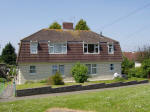 |
| The 1950s witnessed a decline in the traditional semi and a rise in the numbers of flats and maisonettes built by local authorities. Blocks of flats or maisonettes were either low – often being four stories high in a variety of shapes, such as T-blocks, Y-blocks and cruciform blocks - or ‘point blocks’, that is, tall buildings standing alone from their surroundings. The first high rise block was the ten storey block, ‘The Lawn’ at Harlow, Essex, designed by Frederick Gibberd (1908-84) and completed in 1951. The building of blocks of five or more stories accounted for just 9% of local authority building between 1953 and 1959 but increased in the early 1960s to reach a peak of 26% in 1966. High rise flats represented an architectural ideal of architects and planners who had come under the influence of the Modern Movement and pioneers such as Le Corbusier and Walter Gropius in the 1930s. |
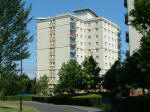 |
|
The high density, vertical city was to replace the outward expansion of the
conventional city which threatened the surrounding countryside. By the
mid-1950s government policy to extend green belt nationwide and a new
subsidy arrangement by which for the first time grants increased with blocks
of more than six stories led to the adoption of tall point blocks of up to
twenty two storeys in Sheffield and Salford. In Glasgow and London some
exceeded thirty stories: Trellick Tower, North Kensington, designed
by Ernő Goldfinger (1902-87) and completed in 1972 has thirty one stories
containing 217 flats and is ninety eight metres (322 ft) tall.
More information on high rise housing can be found in the System Building Topic (from Home Page) |
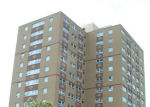 |
| Another key aspect of the tower block vision was the ‘Brutalist’ style of architecture. The name came from the Fench, ‘beton brut’ – or raw concrete - and was coined by the British architects, Alison Smithson (1928-93) and Peter Smithson (1923-2003) in 1954. The Brutalists favoured stark and striking tower blocks with large sections of exposed concrete. Concrete was an integral part of the tower block design. It offered boundless flexibility to the building designers, it was economical – it could be poured on site – and, moreover, it was believed to be long-lasting, if not indestructible. Brutalist architecture relied for its visual impact effect on sheer mass and large expanses of rough, grey concrete. Structural ‘honesty’ and functionalism, in line with Le Corbusier’s original philosophy of the 1920s, guided the Brutalist architects. Where decoration was found, it usually consisted of sections of wall filled with abstract designs in tiles, random stonework or coloured plastics but the overall visual effect of a typical block was created by the seemingly endless repetition of the individual dwelling marked by their large picture windows and shallow balconies. Some towers were linked by flying corridors to service blocks containing laundries or, as at Trellick Tower (right), to a separate full height tower containing the lifts and services. |
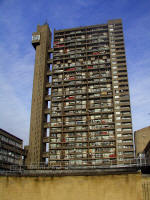 |
| Cumbernauld, a new town in Lanarkshire begun in 1955 was built as a Corbusian concrete utopia and in Sheffield, Park Hill, a massive Brutalist concrete structure built on a hill overlooking the centre of the city was intended to signal the rejuvenation of the town and provide quality homes in a deprived area. Built in 1961, Park Hill was designed by two young Modernist architects, Ivor Smith and Jack Lynn. It consisted of huge snake-like blocks containing 995 dwellings, housing over two thousand people. The front door of each apartment opened onto a twelve-feet wide access deck – or 'street' - which ran from one side of the complex to the other. Bridges carried the street through the entire scheme enabling milk floats to pass from door to door. The architects were keen to preserve a sense of community and as the lobby space in other Modernist blocks tended to become a no-man's land, serving neither public needs nor offering privacy to residents, it was hoped that the 'streets' would solve this problem whilst preserving something of the atmosphere of traditional street life. So that the residents' individuality would not be smothered by the gargantuan surroundings, different coloured linoleum was laid at each doorstep. But attempts to create a sense of community within the bleak, concrete environment of large, concrete blocks failed and developments such as Cumbernauld New Town and Park Hill came to be almost universally loathed. Mounting criticism of their social and visual short comings and the structural failure of Ronan Point – a twenty three-storied prefabricated concrete tower block in Newham, London in 1968 caused a strong reaction against the building of more high-rise blocks. After 1970, the concrete tower block was no longer seen as a workable model for urban regeneration although several blocks including The Lawn, Trellick Tower and the Park Hill complex have been given listed status by English Heritage. |
 |
| The Parker Morris report of 1961 recommended standards for all new homes, public and private which reflected changing patterns of living with more informality in the way space in the house was used. The main recommendations were for more living and circulation space and better heating throughout the house so that all spaces could be used freely. The idea of a parlour set aside for best was abandoned in favour of two living spaces, one for private or quiet activity and the other for eating although the latter could be part of an enlarged kitchen. The kitchen was to be extensively fitted and provided with plenty of space for storage and the use of electric domestic appliances, such as washing machines and refrigerators. These recommendations were made mandatory for public sector housing in 1967 and briefly for local authority housing in 1969 and although they were never made mandatory for private housing their influence was widely felt. | |
| In the private sector there was a marked trend towards a growth in the size of operations with large building firms such as Taylor Woodrow, Laing and Wimpey using architects to bring high standards of construction and design to the privately built post-war house. Typical features of the plan included garages linked or integrated with the main house – covered but open fronted parking spaces were marketed as ‘car-ports’; some halls were spacious and well lit with low horizontal or long vertical windows and overlooked by ‘gallery’ landings. Other features of the interior included L-shaped open living areas with space for dining area at one end and opening through french windows to a paved sitting-out area, the ‘patio’; a downstairs W.C or small ‘study’ was often incorporated in the downstairs plan. In keeping with the Parker Morris report, some kitchens contained a dining space so that they became family rooms whilst there was much emphasis on the luxury fitted kitchen with a stainless steel sink and work tops. |
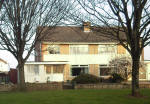 |
| Exterior styling varied but there were, nevertheless, common characteristics which give sixties housing an identity of its own. Plain, flat wall surfaces with large oblong ‘picture’ windows were typical. The windows usually had robust wooden frames with opening top lights. Front doors were usually glazed in small glazed panels, usually with rippled glass whilst the woodwork was painted a light colour: white, pale sky blue or primrose yellow were popular. Some roofs were flat but the typical sixties house has a low pitched roof with an end gable finished with a prominent but unadorned barge board painted white. Roof tiles were generally of brown or grey concrete and although red brick walls were found on 1960s housing, light brown, grey or buff coloured bricks were widely favoured. Claddings of tiles (usually of concrete), white painted boarding applied between the ground and first windows typified the 1960s house and continued to be popular into the 1970s. |
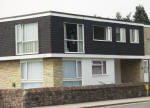 |
| The external design of some houses took their inspiration from Scandinavian models and these are instantly recognisable for their steeply pitched roof - gable to the front - filled with vertical timbers and sweeping almost to the ground. The same effect was often continued inside with pine panelled kitchens and timbered ceilings. Also popular in the 1960s were neo-Georgian style characterised by red brick walls, pedimented porches, small paned windows and fake louvered shutters. A larger style was sometimes called the ‘Colonial’ with double garages under a colonnaded facade incorporating bow windows and concrete urns. | |
| For the first time in five hundred years the roof line of many new houses was unbroken by chimney stacks. From the early sixties, following the recommendations of the Parker Morris report houses most new houses were built new with full or partial central heating; moreover, the use of open coal fires had declined since the passing of the Clean Air Act in 1956. Some houses retained an open fireplace as a feature with a prominent end gable flue sometimes built – or at least clad - in stone to add ‘character’ to the house whilst in the living room, the fireplace opening was surrounded in stonework: In the later 1960s, ‘Cotswold’ stone fireplaces became popular, regardless of the underlying local geology. The grate often contained a back boiler capable of heating two or three radiators and a towel rail although after 1960 oil fired central heating systems were widely adopted. Comfort, convenience and efficiency – in the utilisation of space and the consumption of energy - were now established as the chief factors shaping the future of urban house design. | |
©2009 University of the West of England, Bristol
except where acknowledged